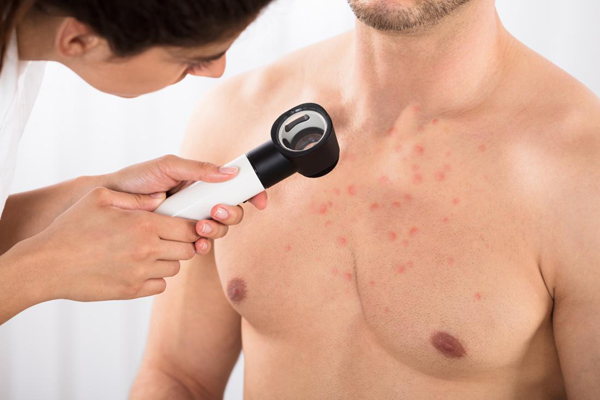6 Tips for Getting Rid of Chest Acne : Chest acne can be quite a nuisance, especially during the summertime when you may want to show more skin.
Chest acne is not rare – it’s a common area for acne to form. Just like on your back, shoulders, and face, the sebaceous glands on the chest can become overloaded with excess oil or dead skin cells, causing plugged pores that lead to the formation of whiteheads or pimples, and inflammation.
Unwanted breakouts can also occur from lack of skincare, increased bacteria on the skin, hormones, diet, sweat, and friction from clothing.
Fortunately, you can get rid of your chest acne and have that clear skin you will be delighted to show off. However, you should also know that acne can be persistent. Here are six tips you can use to fight chest acne:

1. Drink plenty of water
The skin is the largest organ in the body. It needs a lot of water to function on a healthy level, to stay hydrated, and to flush out toxins. You should try to drink at least eight to nine glasses of water daily.
Cut out sugary, sweet drinks like smoothies, juices, and soda from your diet. Diet has a substantial effect on the condition of your skin – scientists have found a link between high glycemic load diets and an increased risk of developing acne.
Healthy and tasty green tea can be a healthy alternative to water. Green tea has antioxidants, which help fight free radicals.
2. Choose your workout gear wisely
Fitted workout clothes are beautiful, but they can also result in friction and sweat accumulation that triggers chest acne.
Wear clothes made of linen or cotton as they are the most breathable fabrics. These fabrics also allow sweat to evaporate and prevent it from forming a layer on the chest, which welcomes bacteria to grow and clog your pores.
3. Avoid scented laundry detergents
Is your chest acne fairly new? If yes, then it’s possible certain chemicals in your detergent could be causing your unwanted breakout. The majority of fabric softeners and detergents include fragrances and dyes. To be safe, just avoid them or try a new washing detergent. Look for washing detergents labeled as hypoallergic.
4. Don’t use oily moisturizers
To keep your body pores gunk free, use lightweight moisturizers as they go easy on the oil, which is one of the causes of chest acne. Oily moisturizers will not allow your skin to breath, so you should avoid thick lotions to maintain clear skin.
5. Shield your skin from the sun
This skin condition has no shortage of myths and misconceptions floating around it. Most people believe that the sun can somehow cure or reduce acne. Using sun exposure as an acne treatment can have many short and long-term consequences, which can affect your overall well-being and health.
The sun doesn’t cure or eliminate acne. It only makes it less visible because of the darkening skin. The sun isn’t an effective or safe form of acne treatment, and it can worsen the problem by causing additional breakouts and inflammation. Also, sun exposure can increase your risk of skin cancer.
6. Choose a body wash that fights acne
Body washes or cleansers containing 2% salicylic acid serve as a shedding agent that helps to curb acne. Wear exfoliating gloves while you are in the shower and replace them at least once every three months because they can become breeding grounds for bacteria.
Don’t scrub too roughly as you will deplete the natural oils of your skin and irritate your chest acne.
Also, shower regularly to prevent bacteria and sebum from accumulating on your skin, causing acne.
Conclusion
If you find your chest acne isn’t responding to any recommended treatment, then it might be because you are not actually dealing with acne. Conditions such as inflamed hair follicles and folliculitis (infected follicles) tend to look like acne.
However, some of those conditions can sometimes be treated like acne. So, visit your doctor to be sure you get the treatment you need.




